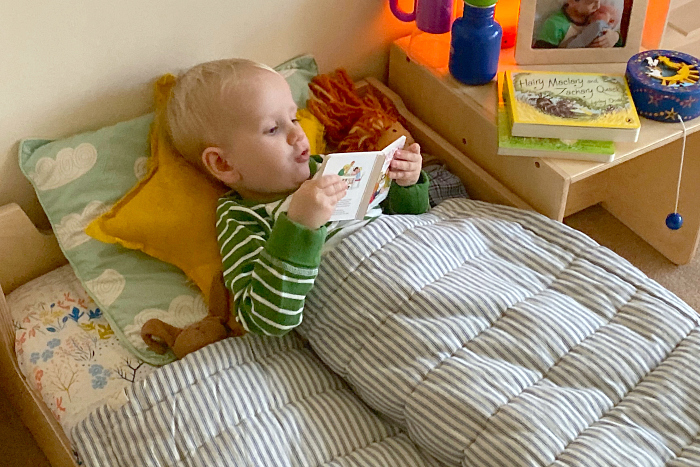The way our babies and toddlers sleep is something that intrigues most parents. We wonder when our baby will sleep through the night. We wonder if we have to train our children to sleep independently. We worry that we might spoil our child by breastfeeding her to sleep or by rocking her to sleep. We ask “is it safe to bed share?” or “Is it OK to let him cry out?”.
what were your preconceived ideas about sleep and here are the 6 main ones
- Montessori promotes independent sleep
- Montessori is against cuddling/breastfeeding to sleep
- Montessori is against co-sleeping
- In Montessori, the floor bed is a must
- You follow the child so you do whatever the child needs to make him ready and comfortable to sleep
- Freedom to decide when to sleep and for how long.

Montessori promotes independent sleep
Maria Montessori talked about sleep in several of her books.
She said that children were made to sleep for longer than they needed. She said that if we were giving them a choice, they would self-regulate and sleep when they needed to. She was against all kinds of strict schedules for children.
But what most “modern” parents understand under “independent sleep” would be that Montessori or her successors were against “helping our children to fall or to stay asleep” so more about “promoting self-soothing”.
During my AMI training, several of us asked our trainer about Cry it out and self-soothing. My trainer was clear that babies have needs and each cry is a way of communicating. She encourages parents and practitioners to respond to the baby’s needs and to always check on their children. However, responding to your baby’s needs doesn’t mean that you have to introduce “some aids to sleep”. That leads me to the second and third statements…
Montessori is against cuddling or breastfeeding to sleep & Montessori is against co-sleeping
While living in India (from 1939 to 1946), Maria Montessori had the opportunity to observe babies and toddlers. She observed as opposed to Western cultures, babies were everywhere. While in Europe and the US, they were kept in cribs and cradles, in India, extended families lived together, all generations from oldest to youngest, sharing a bedroom and a home. She observed that babies were kept at the center of family life and not taking care of by a nanny, away from their parents. She observed that the young baby was often at her mother’s breast. At the time, in western families, mothers were encouraged to weigh the baby before and after breastfeeding him, to not feed more than a certain amount, and to feed on a schedule. This was something she had observed in 1936 and was against the practice, believing that surely the baby knew best. She was at the time an early believer in “feeding on demand”.
In my opinion, co-sleeping is a great way to cope with sleep in the early years. Babies and toddlers need reassurance, if you breastfeed, it’s easier to co-sleep, and believe me, they will stop! Co-sleeping and floor bed were a perfect combination for us!

In Montessori, the floor bed is a must
Do you need a floor bed? In a nutshell, as Montessori is all about giving freedom to your child, the floor bed is a great option. If your child is still in a cot when he starts to move, that will restrict his movements and he will be less able to decide when to sleep and when he has had enough sleep.
In Maria Montessori speaks to parents, a collection of lectures aimed at parents, Montessori described her godson bedroom: “Before he could talk, when he was only 10 months old, he was given his own room, where he was free to engage in his own activities. Perhaps you will be surprised when I tell you what the room contained: in the centre of the floor was a carpet, in one corner was Felicino’s bed – not a cot with high railings to keep him shut up in a cage, but a low bed – and in another corner his mother’s bed, which consisted of a mattress on the floor”.
Note here, that his mother was sleeping in the same room. As it was in the 40’, she was likely breastfeeding. So I would describe that as a co-sleeping situation with likely some cuddles and nursing going on during the night.

The child’s cot is a cage on high supports, so that the grown-up can handle the child without stooping, and so that he can leave the child alone, sure, that though, he may cry, he cannot hurt himself. The room is darkened so that no light, not even the light of dawn, may shine to waken him.
The child must go to sleep early in the evening so as to leave his parents free, and he must sleep late in the morning till they have had the sleep necessary for grown-ups who have gone to bed late.
In her 1946 London lectures, she also said:
The child must be free during the day but also at night.
She said that after 2 years of age, the child should have a mattress on the floor to sleep on. It is safe to say that you can adopt the floor bed earlier if you wish.
The aid to life initiative (recognized by the Association Montessori International) recommends a low bed from the beginning.
Sleeping on the floor is common practice in many parts of the world such as Japan. If you are afraid to expose your child to draught, consider this; we are happy for children to sleep in the fresh air. Children have their naps in the garden in many nurseries in Northern countries. However, we are afraid of a little draught that comes inside through the crack of the door. We are also happy to sleep with a window open no matter the weather. So why all this fuss?
In Understanding the Human being, Dr. Montenaro said: Whenever such a bed is suggested to future parents preparing for birth, the typical objection is that the child is likely to fall from the bed. However, after many decades of direct experience, we can confidently report that this never happens and cannot happens if the bed is used from the very beginning. This is because the infant’s movements are very slow.
Having said all that, depending on when you discover Montessori, you may have a child who is happy in his cot. By all means, do whatever works for your family. Respect your child and respect your needs.
If your child is in a cot, ensure that you answer when your child calls you as he cannot come to you or explores his bedroom when he is done sleeping. You will also need to observe when he is ready to go on a toddler bed as your child could start climbing out of his cot sooner than you think.

Freedom to decide when he needs sleep
If you give your child a floor bed, then you need to accept that he will decide when he is done sleeping. Both my children stopped napping around 2 years and a half. They would occasionally fall asleep in the car or when they have had a very busy day.
But as Maria Montessori noticed in the Secret of childhood: If a child is so alert and so quick to observe, he is not a “sleeper” by his very nature. He needs of course, and certainly should get, a normal amount of sleep, but it is necessary to distinguish between what is suitable and what is artificially induced”. She finished by saying “an adult who forces a child to sleep more than he needs is unconsciously forcing his own will upon the child through the power of suggestion.
She also said in that same chapter: A child should be permitted to go to sleep when he is tired, to wake up when he is rested, and to rise when he wishes.
Respecting our children’s sleep patterns doesn’t mean that we cannot encourage a healthy sleep routine. Each day has a rhythm and that helps children to wind down at the end of the day. But being strict about a specific time to sleep, or an amount of hours is unrealistic and probably not in line with your child’s natural needs.
Conclusion:
In the Montessori world, many ideas are circulating about sleep. I hope that connecting with what Maria Montessori said, what the Montessori trainers said, can help you to make up your mind about what your family needs regarding sleep.
It is not the end of this sleep series. In an upcoming blog post, I will discuss more in-depth how-to promotes healthy sleep for you and your child!
You may be interested by my other blog post about where to find a Montessori floor bed.
So what do you think about Montessori and sleep? Do you have a floor bed? Are you worried about how your child is sleeping? Leave me a comment!



